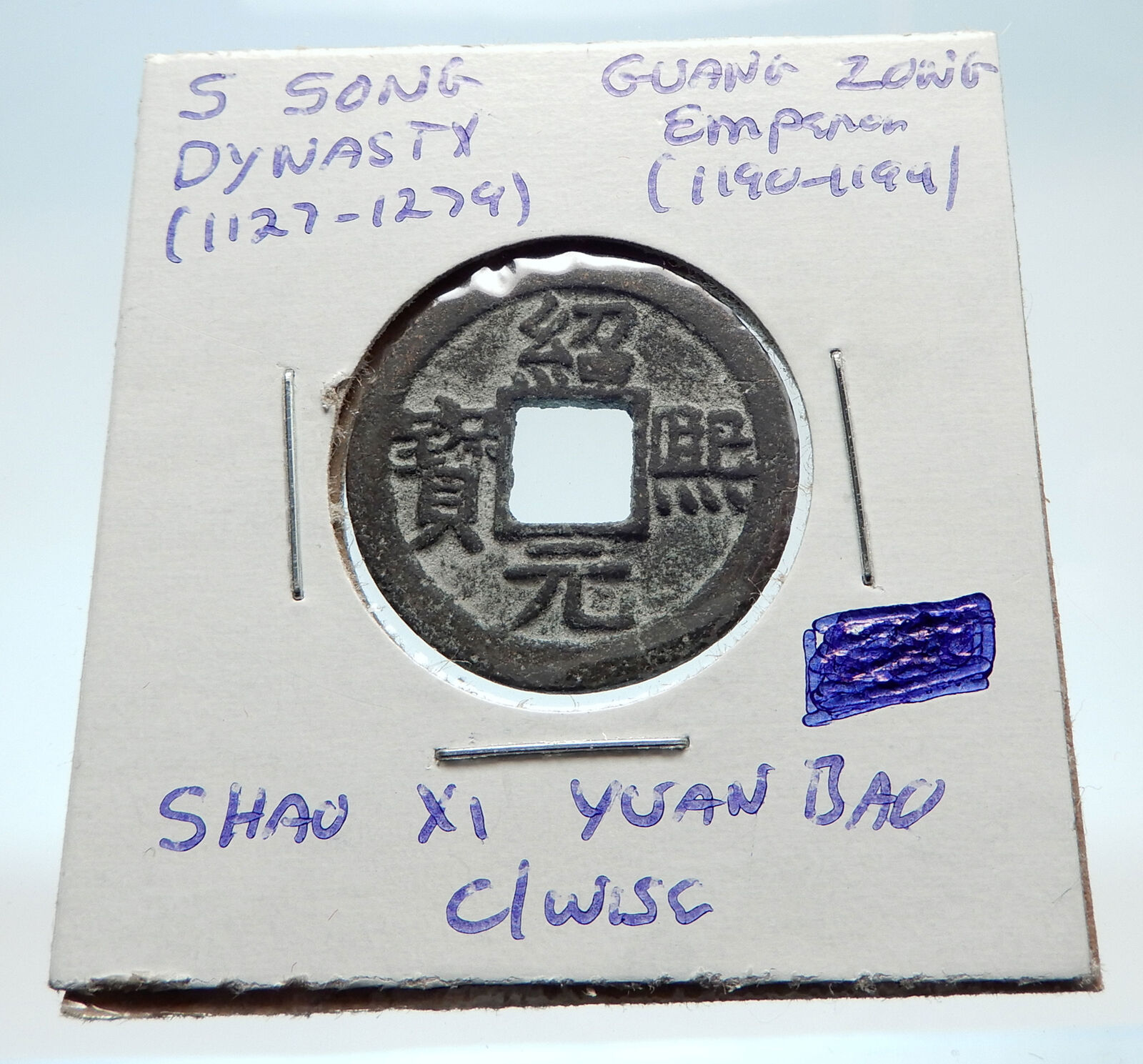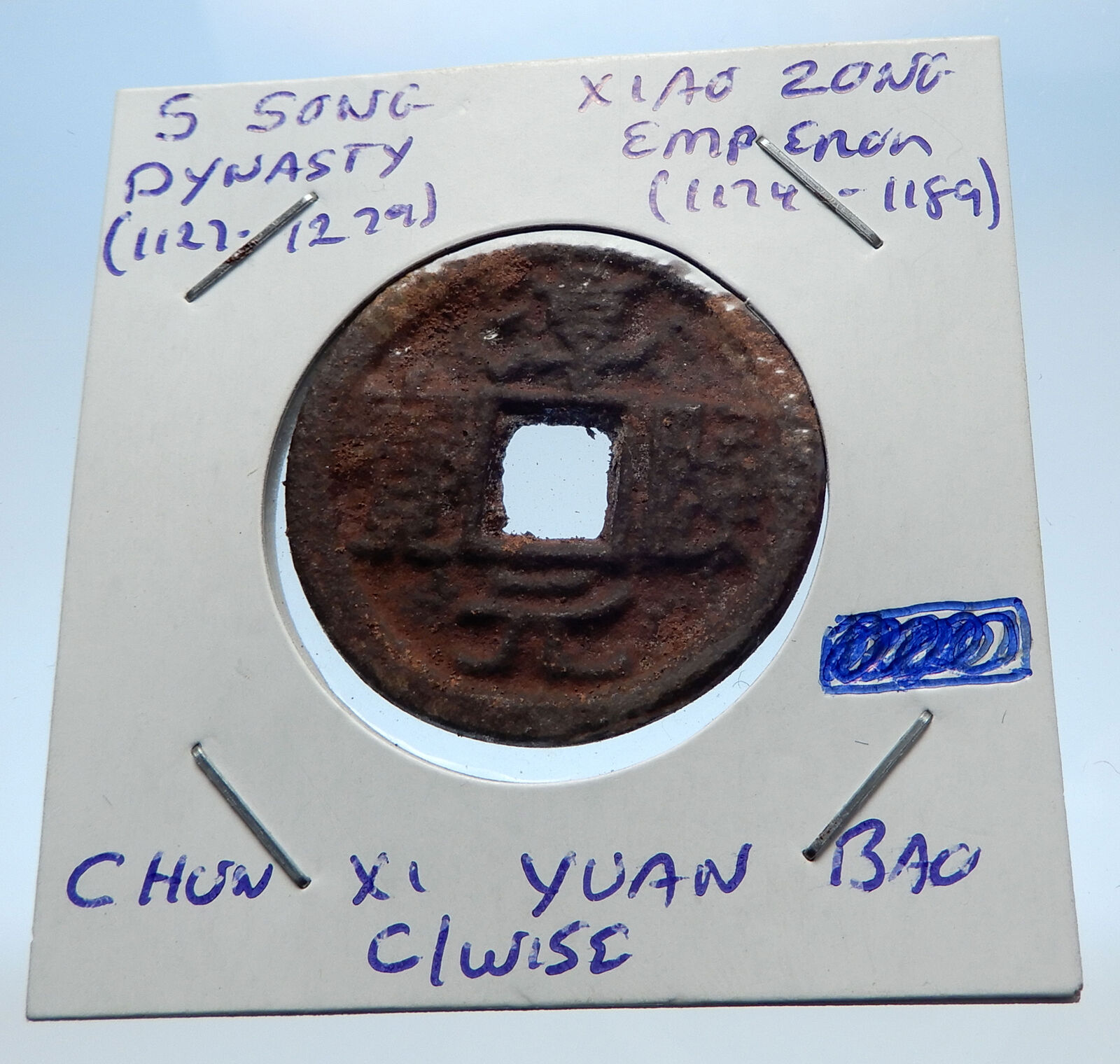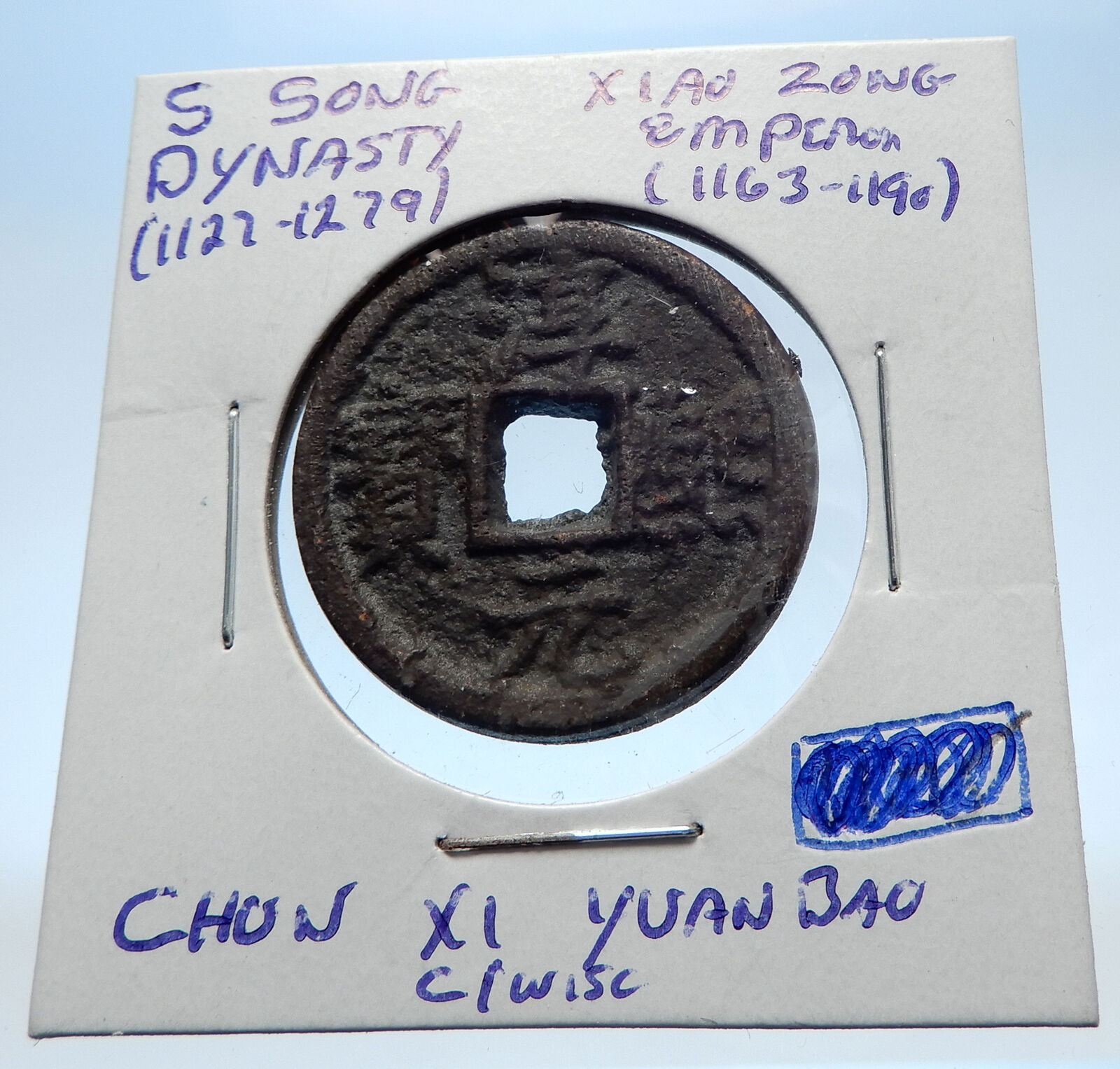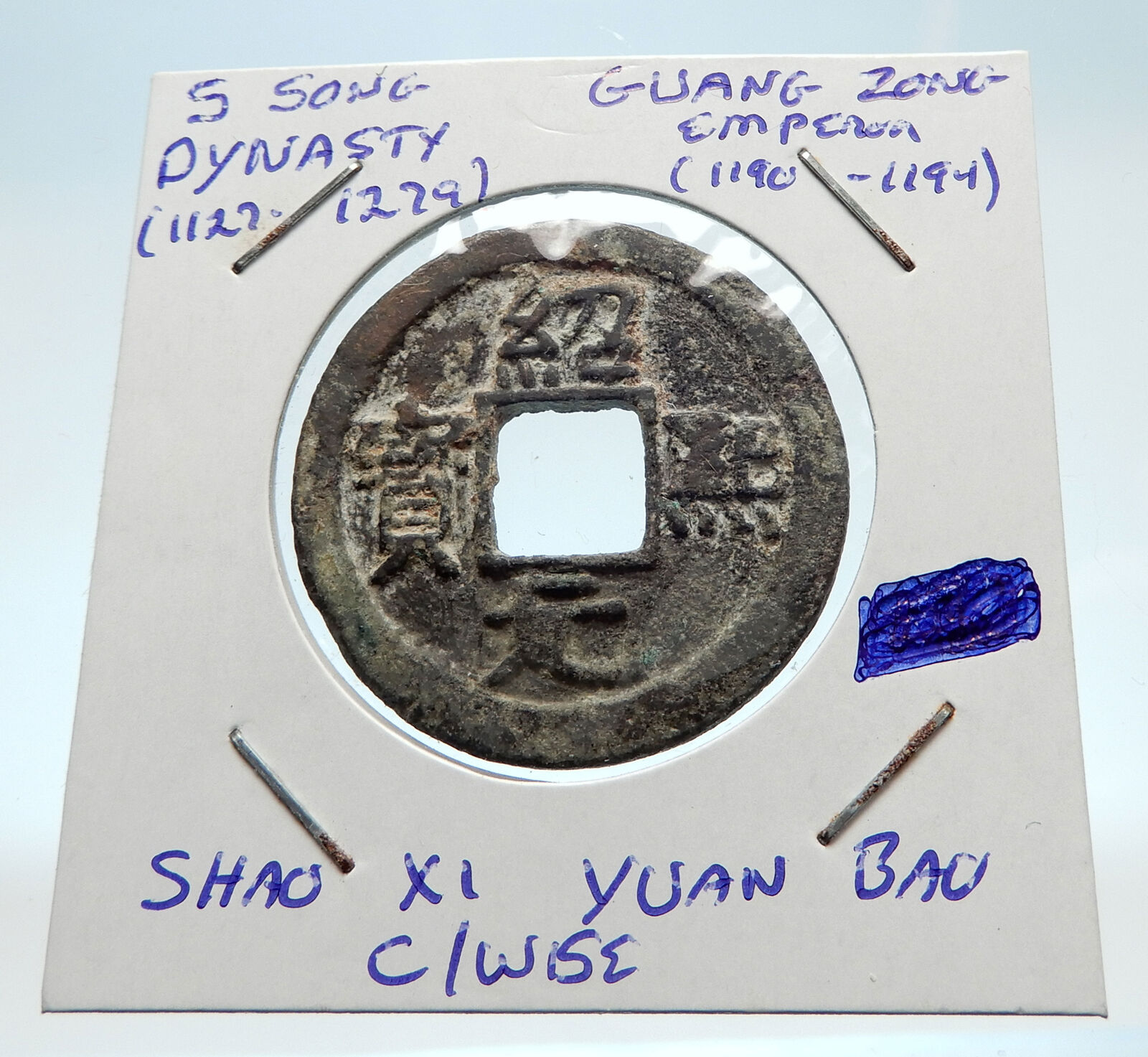|
China – Xin Dynasty (9-23 AD)
Wang Mang: Emperor 9-23 AD
Bronze Spade Token 23mm x 57mm (15.20 grams), Struck 14-22 AD
Reference: H# 9.30
Symbols within spade shape, hole atop.
Huo Bu (Money Spade) Weight:25 Zhu (Equal to 25 Huo Quans)
You are bidding on the exact item pictured, provided with a Certificate of Authenticity and Lifetime Guarantee of Authenticity.
 Wang Mang (Chinese: 王莽) (c. 45 BC – 6 October 23 AD), courtesy name Jujun (Chinese: 巨君; pinyin: Jùjūn), was the founder and the only emperor of the short-lived Chinese Xin dynasty. ] He was originally an official and consort kin of the Han dynasty and later seized the throne in AD 9. The Han dynasty was restored after his overthrow, and his rule marked the separation between the Western Han dynasty (before Xin) and Eastern Han dynasty (after Xin). Some historians have traditionally viewed Wang as a usurper, while others have portrayed him as a visionary and selfless social reformer. Though a learned Confucian scholar who sought to implement the harmonious society he saw in the classics, his efforts ended in chaos. Wang Mang (Chinese: 王莽) (c. 45 BC – 6 October 23 AD), courtesy name Jujun (Chinese: 巨君; pinyin: Jùjūn), was the founder and the only emperor of the short-lived Chinese Xin dynasty. ] He was originally an official and consort kin of the Han dynasty and later seized the throne in AD 9. The Han dynasty was restored after his overthrow, and his rule marked the separation between the Western Han dynasty (before Xin) and Eastern Han dynasty (after Xin). Some historians have traditionally viewed Wang as a usurper, while others have portrayed him as a visionary and selfless social reformer. Though a learned Confucian scholar who sought to implement the harmonious society he saw in the classics, his efforts ended in chaos.
In October 23 AD, the capital Chang’an was attacked and the imperial palace ransacked. Wang Mang died in the battle. The Han dynasty was re-established in either 23 AD when the Gengshi Emperor took the throne, or in 25 AD when Emperor Guangwu of Han took the throne after defeating the Red Eyebrows who deposed the Gengshi Emperor.
 The Xin dynasty (/ʃɪn/; Chinese: 新朝; pinyin: Xīncháo; Wade–Giles: Hsin¹-chʻao²; lit. ‘New dynasty’) was a short-lived Chinese dynasty which lasted from 9 to 23 AD, established by the Han dynasty consort kin Wang Mang, who usurped the throne of Emperor Ping of Han and the infant “crown prince” Ruzi Ying to rule the empire over a decade before being overthrown by rebels. After Wang’s death, the Han dynasty was restored by Liu Xiu, a distant descendant of the Emperor Jing of Han; therefore, the Xin dynasty is often considered an interregnum period of the Han dynasty, dividing it into the Western Han (or “Former Han”) and the Eastern Han (or “Later Han”). The Xin dynasty (/ʃɪn/; Chinese: 新朝; pinyin: Xīncháo; Wade–Giles: Hsin¹-chʻao²; lit. ‘New dynasty’) was a short-lived Chinese dynasty which lasted from 9 to 23 AD, established by the Han dynasty consort kin Wang Mang, who usurped the throne of Emperor Ping of Han and the infant “crown prince” Ruzi Ying to rule the empire over a decade before being overthrown by rebels. After Wang’s death, the Han dynasty was restored by Liu Xiu, a distant descendant of the Emperor Jing of Han; therefore, the Xin dynasty is often considered an interregnum period of the Han dynasty, dividing it into the Western Han (or “Former Han”) and the Eastern Han (or “Later Han”).
After the death of Emperor Wu of Han, the ruling Liu family was increasingly beset by factional struggles. As result, the power of the imperial clan declined. In contrast, the Wang family grew powerful during the rule of Emperor Cheng of Han, and its leading member Wang Mang used his influence to act as regent for several young puppet emperors. In contrast to other Wang family members who were content to rule the empire by influencing the Han emperors, Wang Mang had greater ambitions. He embarked on a programme of building and learning, creating much positive publicity and propaganda for himself. He openly presented himself as champion of Confucian virtues, and as guiding force of the empire. Following the death of Emperor Ping of Han in 6 AD, Wang Mang cemented his control over the empire. Rebellions against his de facto rule were crushed in 6 and 7 AD. Two years later, Wang usurped the throne and officially proclaimed the Xin (literally the “New dynasty”). Though he enjoyed no great support among the empire’s political class, Wang’s ascension was generally tolerated because the Han dynasty had lost most of their prestige. Regardless, much of the old bureaucracy and nobility was still loyal to the Han dynasty, but these loyalists did not openly oppose the establishment of the Xin regime.
In contrast, relations with the nomadic Xiongnu confederation quickly deteriorated, and the latter intended to intervene in China around 10/11 AD. Wang responded by mobilizing 300,000 soldiers along the northern border and prevented the Xiongnu from invading China. The continuing disputes with the northern confederation resulted in Wang setting up a rival Xiongnu government in 19 AD, while maintaining the great army at the border. This drained the Xin dynasty’s resources, weakening its grip on the rest of the empire.
The new emperor initiated several radical social and political reforms. These aimed at strengthening the central government, restoring the failing economy, weakening the powerful noble families, and improving the livelihood of the empire’s peasants. The reforms enjoyed some initial successes, and provided a much-needed legitimacy boost to the Xin dynasty. At the same time, the reforms weakened the former imperial clan, as most of the redistributed resources had belonged to the Liu family. Furthermore, Wang patronized education based on Confucianism, taking the Duke of Zhou as his model for a good ruler. His policies were often not implemented by the old bureaucracy who resented his radical reforms. In contrast, the reforms found some acclaim among the empire’s peasants.
Soon after its inauguration, Wang’s regime was destabilized by several natural disasters, including the Yellow River changing course, which resulted in massive floods. Plagues of locusts further worsened the situation, and widespread famines broke out. The Xin dynasty’s economic policies failed to solve the ensuing crisis, and Wang Mang quickly lost the support which he had had among the peasantry as the latter struggled for survival. The desperate peasants in the eastern parts of the empire soon turned to banditry. The bandit groups grew in strength, and numbered tens of thousands of members by the 20s. The most powerful factions along the Yellow River reorganized into rebel armies, known as the Red Eyebrows. The insurgents allied with discontented nobles and descendants of the former imperial clan, resulting in large-scale civil war by 19 AD. Wang Mang was forced to shift troops from other areas to deal with the Red Eyebrows, whereupon the Protectorate of the Western Regions was overrun by the Xiongnu. Smaller rebellions broke out in other parts of China. The “Troops from the Lower Yangtze” operated along this river, while two insurgent bands in Hubei were recruited by Han loyalists. Led by Liu Bosheng, they became known as the Lulin.
As civil war engulfed the entire Xin Empire, Wang’s loyalist armies fought hard to keep the rebels at bay. The Xin armies scored several victories, but were completely defeated by Han restorationist armies in the Battle of Kunyang in June–July 23 AD. Upon hearing of this event, the irregular militias of Zhuang Ben and Zhuang Chun captured Chang’an in October 23, plundering the capital and killing Wang Mang. The various rebel armies subsequently fought each other to gain full control over the empire. In 25 AD, Liu Xiu was crowned as Emperor Guangwu of Han in Luoyang. The Red Eyebrows were defeated by Liu Xiu’s forces in 27 AD, and he also destroyed other rival claimants as well as separatist regimes including Wang Lang’s Zhao state, Gongsun Shu’s Chengjia empire, and warlord Wei Ao in the northwest. By 37 AD, the Han dynasty was fully restored.
Cash was a type of coin of China and East Asia, used from the 4th century BC until the 20th century AD. Originally cast during the Warring States period, these coins continued to be used for the entirety of Imperial China as well as under Mongol, and Manchu rule. The last Chinese cash coins were cast in the first year of the Republic of China. Generally most cash coins were made from copper or bronze alloys, with iron, lead, and zinc coins occasionally used less often throughout Chinese history. Rare silver and gold cash coins were also produced. During most of their production, cash coins were cast but, during the late Qing dynasty, machine-struck cash coins began to be made. As the cash coins produced over Chinese history were similar, thousand year old cash coins produced during the Northern Song dynasty continued to circulate as valid currency well into the early twentieth century.
In the modern era, these coins are considered to be Chinese “good luck coins”; they are hung on strings and round the necks of children, or over the beds of sick people. They hold a place in various superstitions, as well as Traditional Chinese medicine, and Feng shui. Currencies based on the Chinese cash coins include the Japanese mon, Korean mun, Ryukyuan mon, and Vietnamese văn.
|





 Wang Mang (Chinese: 王莽) (c. 45 BC – 6 October 23 AD), courtesy name Jujun (Chinese: 巨君; pinyin: Jùjūn), was the founder and the only emperor of the short-lived Chinese Xin dynasty. ] He was originally an official and consort kin of the Han dynasty and later seized the throne in AD 9. The Han dynasty was restored after his overthrow, and his rule marked the separation between the Western Han dynasty (before Xin) and Eastern Han dynasty (after Xin). Some historians have traditionally viewed Wang as a usurper, while others have portrayed him as a visionary and selfless social reformer. Though a learned Confucian scholar who sought to implement the harmonious society he saw in the classics, his efforts ended in chaos.
Wang Mang (Chinese: 王莽) (c. 45 BC – 6 October 23 AD), courtesy name Jujun (Chinese: 巨君; pinyin: Jùjūn), was the founder and the only emperor of the short-lived Chinese Xin dynasty. ] He was originally an official and consort kin of the Han dynasty and later seized the throne in AD 9. The Han dynasty was restored after his overthrow, and his rule marked the separation between the Western Han dynasty (before Xin) and Eastern Han dynasty (after Xin). Some historians have traditionally viewed Wang as a usurper, while others have portrayed him as a visionary and selfless social reformer. Though a learned Confucian scholar who sought to implement the harmonious society he saw in the classics, his efforts ended in chaos. The Xin dynasty (/ʃɪn/; Chinese: 新朝; pinyin: Xīncháo; Wade–Giles: Hsin¹-chʻao²; lit. ‘New dynasty’) was a short-lived Chinese dynasty which lasted from 9 to 23 AD, established by the Han dynasty consort kin Wang Mang, who usurped the throne of Emperor Ping of Han and the infant “crown prince” Ruzi Ying to rule the empire over a decade before being overthrown by rebels. After Wang’s death, the Han dynasty was restored by Liu Xiu, a distant descendant of the Emperor Jing of Han; therefore, the Xin dynasty is often considered an interregnum period of the Han dynasty, dividing it into the Western Han (or “Former Han”) and the Eastern Han (or “Later Han”).
The Xin dynasty (/ʃɪn/; Chinese: 新朝; pinyin: Xīncháo; Wade–Giles: Hsin¹-chʻao²; lit. ‘New dynasty’) was a short-lived Chinese dynasty which lasted from 9 to 23 AD, established by the Han dynasty consort kin Wang Mang, who usurped the throne of Emperor Ping of Han and the infant “crown prince” Ruzi Ying to rule the empire over a decade before being overthrown by rebels. After Wang’s death, the Han dynasty was restored by Liu Xiu, a distant descendant of the Emperor Jing of Han; therefore, the Xin dynasty is often considered an interregnum period of the Han dynasty, dividing it into the Western Han (or “Former Han”) and the Eastern Han (or “Later Han”).




